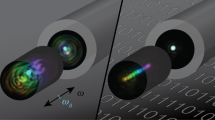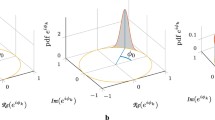Abstract
With the rapid increase in the data rates transmitted over optical systems, as well as with the recent extension of terrestrial systems to ultra-long haul reach, polarization mode dispersion (PMD) has become one of the most important and interesting limitations to system performance. This phenomenon originates from mechanical and geometrical distortions that break the cylindrical symmetry of optical fibers and create birefringence. It is the random variations of the local birefringence along the propagation axis of the optical fiber that create the rich and complicated bulk of phenomena that is attributed to PMD. The detailed statistical properties of the local birefringence and its dependence on position are only important as long as the overall system length is comparable with the correlation length of the birefringence in the fiber. In typical systems, however, the latter is smaller by more than three orders of magnitude so that the specific properties of the local birefringence become irrelevant. Instead, the fiber can be viewed as a concatenation of a large number of statistically independent birefringent sections characterized only by the mean square value of their birefringence. This model has been used extensively in the study of PMD and its predictions have been demonstrated to be in excellent agreement with experimental results. This approach opens the door to the world of stochastic calculus, which offers many convenient tools for studying the PMD problem. In this article we review the modelling of PMD and discuss the properties of this phenomenon as a stochastic process. We explain the use of stochastic calculus for the analysis of PMD and describe the derivation of the frequency autocorrelation functions of the PMD vector, its modulus and the principal states. Those quantities are then related to commonly used parameters such as the bandwidth of the first order PMD approximation, the bandwidth of the principal states and to the accuracy of PMD measurements.
Similar content being viewed by others
References
H. Kogelnik, R. M. Jopson and L.E. Nelson, Polarization mode dispersion. In: Optical Fiber Telecommunications IVb: Systems and Impairments, edited by I.P. Kaminow and T. Li (Academic Press, San Diego, 2002), Chap. 15.
M. Born, E. Wolf, Principles of Optics, 6th Ed. (Pergamon, New York, 1986)
R.M.A. Azzam, N. M. Bashara, Ellipsometry and Polarized Light (NHPL, Elsevier, New York, 1977)
D.S. Kliger, J. W. Lewis, C.E. Randall, Polarized Light in Optics and Spectroscopy (Academic Press, New York, 1990)
C. D. Poole InstitutionalAuthorNameR. E. Wagner (1986) Electron. Lett. 22 1029
G. J. Foschini InstitutionalAuthorNameC. D. Poole (1991) J. Lightwave Technol. 9 1439 Occurrence Handle1991JLwT....9.1439F
A. Eyal InstitutionalAuthorNameW. K. Marshall, A. Yariv, M. Tur (1999) Electron. Lett. 19 1658
H. Kogelnik (2004) J. Opt. Fiber Commun. Rep. 1 107–122 Occurrence Handle10.1007/s10297-004-0005-1
R. Ulrich InstitutionalAuthorNameA. Simon (1979) Appl. Opt. 18 2241 Occurrence Handle1979ApOpt..18.2241U Occurrence Handle10.1364/AO.18.002241
C. D. Poole InstitutionalAuthorNameJ. H. Winters, J. A. Nagel (1991) Opt. Lett. 16 372 Occurrence Handle1:CAS:528:DyaK3MXhvFGjsb0%3D Occurrence Handle10.1364/OL.16.000372 Occurrence Handle1991OptL...16..372P
J. P. Gordon InstitutionalAuthorNameH. Kogelnik (2000) Proc. Natl. Acad. Sci. USA 97 4541 Occurrence Handle2000PNAS...97.4541G
N. J. Frigo (1986) IEEE J. Quantum Electron. 22 2131 Occurrence Handle10.1109/JQE.1986.1072917 Occurrence Handle1986IJQE...22.2131F
A. Galtarossa InstitutionalAuthorNameL. Palmieri, M. Schiano, T. Tambosso (2001) Opt. Lett. 26 962 Occurrence Handle2001OptL...26..962G
J. P. Gordon (2004) J. Opt. Fiber Commun. Rep. 1 210–217 Occurrence Handle10.1007/s10297-004-0003-3
F. Curti InstitutionalAuthorNameB. Daino, G. De Marchis, F. Matera (1990) J. Lightwave Technol. 9 1162 Occurrence Handle1990JLwT....8.1162C
M. Shtaif InstitutionalAuthorNameA. Mecozzi (2000) Opt. Lett. 25 707 Occurrence Handle2000OptL...25..707S
C. W. Gardiner, Handbook of Stochastic Methods, Springer Series in Synergetics 13 (Springer, Berlin/Heidelberg/New York, 1985)
M. Karlsson InstitutionalAuthorNameJ. Brentel (1999) Opt. Lett. 24 939 Occurrence Handle1999OptL...24..939K
M. Shtaif InstitutionalAuthorNameA. Mecozzi, J. Nagel (2000) IEEE Photon. Technol. Lett. 12 53
A. Mecozzi, M. Shtaif, IEEE Photon. Technol. Lett., 15, December 2003, available at http://ieeexplore.ieee.org.
N. Gisin InstitutionalAuthorNameB. Gisin, J. P. Won der Weid, R. Passy (1996) IEEE Photon. Technol. Lett. 8 1671 Occurrence Handle1996IPTL....8.1671G
M. Boroditsky, M. Brodsky, P. Magill, N.J. Frigo, M. Shtaif, “Second order PMD statistics analyses improves the accuracy of mean DGD estimates,” to be published in IEEE Photon. Technol. Lett. (2004)
Author information
Authors and Affiliations
Corresponding authors
Rights and permissions
About this article
Cite this article
Shtaif, M., Mecozzi, A. Modelling of polarization mode dispersion in optical communications systems. J Optic Comm Rep 1, 248–265 (2004). https://doi.org/10.1007/s10297-004-0002-4
Issue Date:
DOI: https://doi.org/10.1007/s10297-004-0002-4




